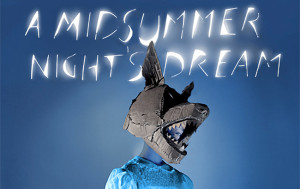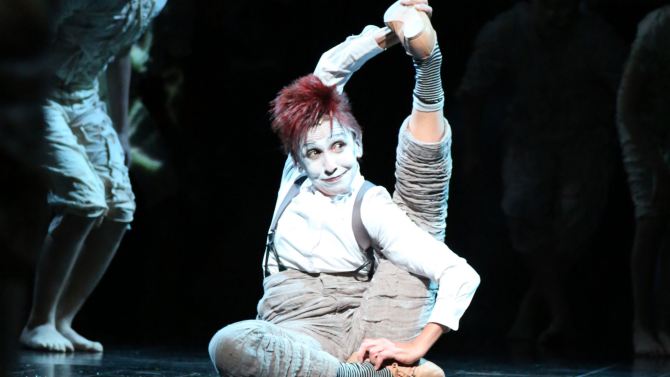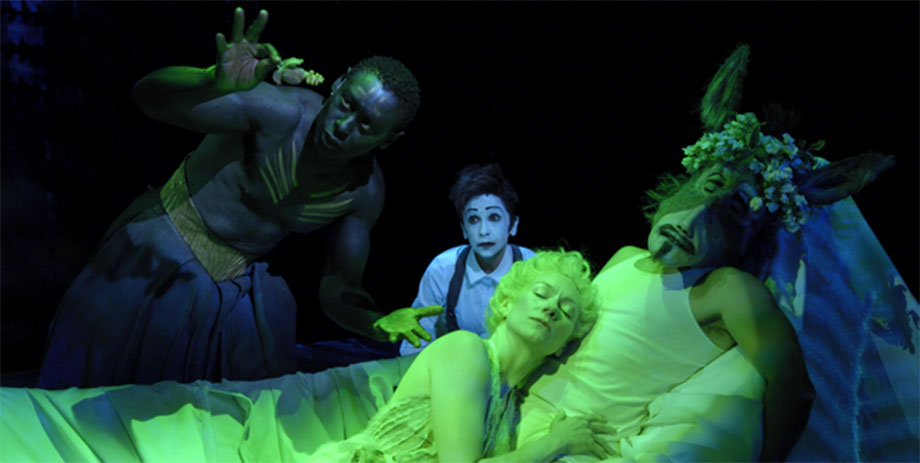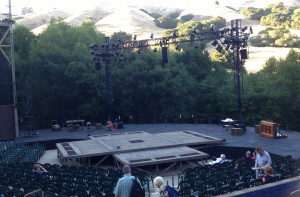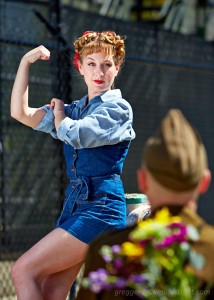Julie Taymor’s A MIDSUMMER NIGHT’S DREAM: a review of the film
July 1, 2015 § 1 Comment
Julie Taymor’s acclaimed production of A Midsummer Night’s Dream for Theatre for a New Audience is now available in a fascinating new film, and it is well worth seeing both for her ideas about the play and about plays on film.
A Play and a Film
Because MND is so much about the theatre itself, it is not a surprise that Taymor has eschewed the location shoots she adopted for her previous Shakespeare films – Titus and The Tempest. This film records her production inside the theatre where it was performed live, capturing the visual splendor and relentless inventiveness for which she is known, but it is quite different than the relatively static live broadcasts of plays for which Britain’s National Theatre has recently become known. Taymor uses a lot of filmic techniques. Cameras on stage capture the action from extremely close distances and viewing angles that no live audience member could ever experience, and (especially at the beginning of the film) the cameras are so active as they quickly pan around the crowded stage that they give the impression of being active participants. At other times the camera becomes such a close confidant of the actors, especially David Harewood as Oberon, that the style of the acting shifts to the whisperingly cinematic.
Occasionally you get a more traditional view of the stage, usually when Taymor is recording the interaction of actors and the extraordinary projections on floating silk banners and canopies that astounded the live audiences in Brooklyn. As impressive as these shots are, this alternation between the conventions of film and theatre is sometimes disconcerting.
Kathryn Hunter, Genius
Both the production and the film are completely built around the performance of the remarkable Kathryn Hunter as Puck. She opens the film as an exhausted sleeper drifting off into dreams, and when the rude mechanicals (as modern dress Brooklyn construction workers) show up and cut her bed free she literally drifts into the grid above the stage like a balloon. Her first full scene, with what is ordinarily a single fairy but is here a full cast of children who sing and chant the scene, establishes her distinctive childlike voice. Her wide-open wonder plays especially strongly in her scenes with Oberon, where she idolizes him like a parent–sometime fearful and sometime delighted to be pleasing him. It is the most fully imagined and realized Puck I have ever seen. For her performance alone, the film is worth your time.
The film is not without theatrical and cinematic flaws. Taymor is frequently more concerned with the big picture than the detail – and almost always prioritizes the visual over the auditory. The sound appears to have been captured through body mics, but sometimes you hear the faint echo of an additional actor’s mic. Often the scansion is sloppy. (At one point the possessive form of Theseus’, which should be two syllables, thes-yus, is rendered as four: Thes-e-us-es!)
Multiethnic and International
The production is especially interesting in the realm of the supernatural, where Taymor’s visual genius prevails, while the “real” world is more mundane. Unfortunately that is not just because the visual presentation is more restrained. It seems the interpretive act was just less interesting to Taymor. The lovers were trivialized, with only Mandi Masden as Helena making an impression, and the admirably multiethnic mechanicals were largely conveyed through broad stereotypes. Max Casella was amusing as a Brooklynese Bottom, but (as is often the case) Flute steals the show from him. In this case it is Zachary Infante’s Spanish speaking Francisco Flute that unlocks the wonder of Shakespeare’s power, as he discovers the ability to invest words he scarcely understands with meaning and power.
The most interesting casting of the evening is Okwui Okpokwasili as the conquered Queen Hippolyta. Both the gender and racial politics of the part were treated lightly, but her powerful presence was more than enough to make the point.
Finding the right level for a film of a play is a complex task. This relatively complete production of the script is FAR more satisfactory than Michael Hoffman’s disappointing, choppy 1999 film, and in many ways is also more pleasing than Adrian Noble’s similarly mixed film/play (1996) of his RSC production, if only because it utilizes more interesting theatrical conventions.
The film is in limited release, but absolutely worth catching on a large screen whenever you can.
Review: ROMEO AND JULIET at CalShakes
July 8, 2013 § 2 Comments
Can it be that the most “authentic” production of a Shakespeare play I’ve seen in years is a modern-dress production of Romeo and Juliet with a cast of seven performing a heavily cut text, accompanied by a pulsing club-inspired sound design? To my great surprise, I believe so.
As a professor of both acting and theater history, I think a lot about what the experience of seeing an original performance of a Shakespeare play must have felt like. It is the effect that I would most want to capture, not the form. We can do a reasonably good job at recreating the look and style of the late sixteenth century theater, but what would have been innovative, contemporary, and engaging then often seems hopelessly stale and distant now that the context has completely changed.
Shana Cooper’s Romeo and Juliet, now playing at the California Shakespeare Theatre near San Francisco, is a stark but simply brilliant, production. It is as far from a museum replica version as possible, yet it recreates all of the Shakespearean theater’s virtues in modern form.
Played on an open stage against no scenic backdrop but the Orinda, Ca. landscape behind CalShakes’ outdoor auditorium, Cooper uses a text-based technique right out of the Elizabethan theater to verbally move us instantly from imaginary location to location on Daniel Ostling’s aggressively thrusting platform set. The visual neutrality focuses all attention on the action, but when it pauses to be beautiful it is breath-taking. Romeo defying stars that you can actually see causes an exhilarating, visceral rush. Lap Chi Chu’s lighting design for the stage is effective, but his subtle lighting of the natural background in the distance, particularly in the eerie tomb scene, is genius.
Performed by an incredibly versatile cast of three women and four men playing some twenty roles in a heavily but skillfully edited version, it was energetically engaging for every moment of the promised (accurately, for once) two hours traffic on the stage. Somewhere between a quarter and half of the traditional text was excised, including all the bit parts. In clumsy hands, that might have given the appearance of financial expediency, but here it focused and sped the narrative so that events felt – as they should – like they were spinning out of control. Early in the second half the scenes in which Romeo and Juliet separately learn he has been banished were intercut in a way that seem stunningly cinematic or, well, Shakespearean. The juxtaposition of the simultaneous scenes was inspired.
The modern dress costumes enhanced the youthful, often rude energy of the performances. Although the period was changed to some quasi-now (where fourteen-year-olds can still be married off at a father’s whim), it read less as a resetting and much more a case of simply becoming invisible to us. I suspect this is the way that contemporary dress on the Elizabethan stage might have affected the Shakespearean audience – it faded into the background, as neutral as the scenery.
The performances were uniformly outstanding. Rebekah Brockman was an unusually aggressive Juliet from her first entrance when she jumped out to frighten the nurse. She has just finished a run of the season’s best production, playing Thomasina in ACT’s Arcadia. Perhaps it is because she was so indelible in that role that she seemed to possess the same combination of tragically under-appreciated intelligence and irrepressible, emerging sexuality here, but it is more probable that she carried it forward to create an equally self-inventing Juliet.
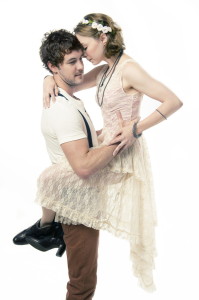
Dan Clegg (Romeo) and Rebekah Brockman (Juliet) in Cal Shakes’ Romeo & Juliet, directed by Shana Cooper; photo by Kevin Berne.
Romeo can be one of the least rewarding roles in the canon. He works incredibly hard in the first half of the play and then slowly fades from view in the second as Juliet’s story eclipses his. Dan Clegg brought unusual charm and skill to the part, and greatly benefited from the extensive cutting of Romeo’s mopiest and dopiest moments. He emerged as a genuinely tragic figure in the tomb scene, most moving when he unsuccessfully sought to scare Paris away to avoid killing him.
The other five cast members all played multiple roles with theatrical verve that made the production electrifying. Nick Gabriel (another veteran of the Arcadia cast) played Tybalt and Paris as entitled hipsters. Domenique Lozano doubled the Prince of Verona with the nurse, and excelled at both parts of this unlikely pairing. Arwen Anderson was a mousy Lady Capulet, but revelatory as Benvolio, where she out-guyed the guys when being one of the guys. Joseph J. Parks was the engine of the first act as the relentlessly and inappropriately libidinous Mercutio. It is, of course, necessary that this comic presence disappear from the last half of the play, and Parks is too irrepressible to hide effectively, but it is too bad that he could not be used for more than a cameo as the apothecary after intermission. He is too good to sacrifice.
The production ultimately rests on the skills of Dan Hiatt, who is onstage almost continuously in the second half as Friar Laurence, quick-changing into Lord Capulet, and then reappearing as the servant Peter. That he could walk to the edge of the platform, slip on a jacket, and return instantly as someone else for scene after scene was a confirmation of what every regular theater-goer in the Bay Area already knows: he is a consummate actor. It is worth the price of admission just to watch his transitions.
The production is so tightly focused, suiting the action to the word and the word to the action, that it is immediately affecting while serving as a model of narrative clarity. One might quibble with the unusual choice to strangle rather than stab Tybalt, only because it renders later references to shedding his blood very odd, but Shana Cooper’s direction is otherwise flawless. The fast-moving staging, stylized fights, smart transitions and beautiful use of the natural surround as scenery combined for the most rewarding (and least gimmicky) Shakespeare I’ve seen in ages. It was fresh and exciting.
I walked away thinking, “I bet that is exactly how it felt at the Globe.”
Review: TAMING OF THE SHREW at the Livermore Shakespeare Festival
July 1, 2013 § 1 Comment
As Director Gary Armagnac disarmingly admits in the notes to his production currently running at the Livermore Shakespeare Festival, The Taming of the Shrew is now a “problem play.” In its time, it was a lightweight comedy about the battle of the sexes won only when the man showed his independent-minded bride some tough love and put her in her place. To play it that way now just reads as painfully misogynistic. If it were not by Shakespeare, it is entirely possible it would be dropped from the repertoire but because it is, the problem now is to figure out how to find something deeper in it. Like any good puzzle, it now has to be “solved.”
Conceptually, Armagnac goes a long way toward rehabilitating Shrew by setting his “Rosie the riveter” production just after the end of World War II, as the troops return home. Petruchio, the protagonist, is portrayed (along with the other male characters) as anxious to get married, settle down and get on with Eisenhower-ifying America – but the women they are coming home to are not the girls they left behind. Armagnac’s resetting highlights the greater social empowerment women felt (and were in danger of losing) from supplying the home work force while men fought the war. That goes a long way to explaining why Kate, the “shrew” of the title, resists with such vitriol the bevy of suitors who want her bucks but not her pluck.
It is the psychologically insightful portrayals of the quarreling couple by Armando McClain and the simply wonderful Jennifer Le Blanc that make it all work. As Petruchio, McClain’s best moment is the soliloquy in which he asks directly if anybody has any better ideas than he does for taming his wife. Although the speech is an extended metaphor about falconry, through subtext he reveals that the only methods this returning army captain has in hand are the ones he used to discipline his troops, and he rightly worries about their current appropriateness.
Le Blanc, who both looks and sounds like a young Helen Hunt, showed us right from the start that the issue was not that she hates men, but that she loves – and fears losing – the scope of her unfettered life. Astonishingly, she somehow never lets us forget she is balancing her genuine fondness for the handsome and confident Petruchio with the desire to retain her independence, including in many scenes where the text has much less substance.
Not that fidelity to the text was much of an issue in the production. Armagnac’s other main conceptual innovation was setting the play right in the very California vineyard where it was being performed, which succeeded in incorporating the beautiful natural setting and led to some very clever moments. (A servant summoning Kate just stuck her head out a second story window and bellowed into the field, from which a grumbling Kate emerged with pruning implements still in hand.)

The mansion on the grounds of Concannon winery that serves as a permanent backdrop for the Livermore Shakespeare Festival
Less successfully, it also meant that all references to Padua were changed to Livermore, Pisa to New York, and from there the floodgates were opened. Horses became jeeps, servants became soldiers, and actual welcome home speeches from the war were inserted into the play. Although resetting the play into a period of rapid, and unsettled, social transformation (not unlike our own) was revelatory, the text was shoehorned into its new shape, and where it would not stretch to fit, just changed wholesale. In previews, many of the biggest laughs from the audience were not at the play’s humor, but at the incongruity of the very unShakespearean inserted material.
The best moments in the production came not from alteration, but from honest delivery of the plot in its new context. Patrick Moore, who already gave one outstanding performance this summer, portraying a loving father in The Liar (the repertory’s other production) delivered again here. As Baptista, he desperately tries to balance the happiness of both his daughters. He is quite moving during Kate’s wedding scene fearing that he’s made a mistake by hastily accepting the mad-seeming Petruchio as her husband to clear the way for Bianca. Rebecca Pingree, another terrific performer cast in both productions, played the minor role of the widow that a suitor must settle for when a rival outmaneuvers him for Kate’s younger sister, Bianca. Pingree brought illuminating gravity to the play’s final scene by playing the widow not as the typical doddering old woman, but as a young girl whose husband was lost in the war.
At least in its final preview, this was a production with an admirable aim that exceeded its grasp. However, with excellent and deeply felt performances from its leads, as well as from the afore-mentioned Pingree and Moore, it still managed to speak to contemporary concerns: it showed us two people negotiating a new kind of relationship in the absence of societal models for doing so. That is a lot to wring out of Shrew.
The production would have been stronger if it had remained faithful to this more serious reading throughout, but the subplots were less carefully considered, and overstuffed with tacked on lazzi. Genuinely successful comic moments were, however, provided by Brian Herndon as an Ensign Pulver-like Tranio, and Jeremy Tribe-Gallardo (an intern with a big future coming) as the funniest Grumio I’ve ever seen.
Pericles at the Berkeley Rep
June 19, 2013 § Leave a Comment
My chief scholarly area of interest is performance of early modern English drama, i.e. the plays of Shakespeare and his contemporaries. As a theatre historian I am also interested in the conditions under which the drama was originally performed, but for their contemporary applications and not some form of historical purity. Indeed, thinking about it recently I realized that in a lifetime of attending Shakespeare live I have never seen a production that so much as attempted an historically correct (whatever that might mean) re-creation, and aside from a few Zeffirelli movie versions can’t even remember anything set in period, without any lack of enjoyment.
My interest then, is not as a purist, but I confess to a fascination with the issue of how modern productions should interpret, extend and/or adapt the written drama. Are the plays ultimately flexible, i.e. tolerant of any and all performance choices, or are there some boundaries – limits to how far they can stretch without breaking? If the latter, what elements of the plays are the source of their enduring power, therefore vitally important?
The great test case is Pericles – the textually troubled step-child of the canon. The play is Shakespeare’s retelling an ancient folktale about a prince’s odyssey around the Mediterranean in search of his lost wife and daughter. Co-written late in his career this “romance” (in the medieval sense of a journey or quest through a partially supernatural landscape) was never published in an authoritative edition so, even more than with the rest of Shakespeare’s plays, there is no definitive script. It has to be “completed.”
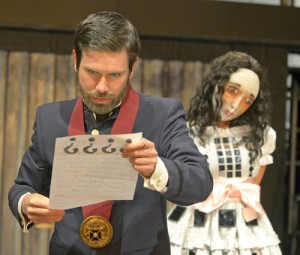 David Barlow and Rami Magron as Pericles and the princess of Antioch
David Barlow and Rami Magron as Pericles and the princess of Antioch
Photo courtesy of mellopix.com
That used to be thought such a drawback that the play was rarely produced, but lately it has become one of the chief appeals of the work. To say that Mark Wing-Davey’s relentlessly eclectic adaptation for eight versatile actors at the Berkeley Rep earlier this spring was less a production of, than a riff on, Pericles just means that it was right in vogue. Wing-Davey’s fame rests on his recontextualizing his texts, and this production confirmed his commitment to the bit. Scene after scene revealed wonderful, unanticipated references ranging from a king costumed like an Assyrian relief as channeled by Klimpt to a wicked stepmother who just stepped out of Sunset Boulevard. But however brilliantly matched this director seemed to be to the task, the production didn’t quite come together – for very instructive reasons.
Although often amusing, his strategy was not always illuminating because Wing-Davey seemed to be placing his considerable invention in service of recontextualizing not the play as a whole, but each individual scene. Occasionally, it appeared, even individual lines. The cumulative effect was too many signifiers without much being signified.
The scenes located in an Italian brothel (already relocated from the text’s Mytilene) into which Pericles’ lost daughter is sold, for example, were inexplicably played using broad Lucy-and-Ricky Cuban accents and comic stereotypes. Pericles was clearly on a wide-ranging odyssey, but his trip seemed less a Joseph Campbell-style hero’s journey and more like a mashup of Hope-Crosby road movies.
This worked best in a long first act sequence in which the hero, Pericles, entered a tournament where the jousting knights were introduced with classical mottoes but individually materialized (after rapid fire costume changes by the tiny cast) in such whimsical guises as Napoleon and then Batman. After winning the tournament, Pericles proved himself not just the bravest knight but also the most graceful dancer with a decent Justin Timberlake imitation, and then shyly wooed his intended bride at a “crowded,” but literally faceless, banquet created by just four actors playing the throng in triple-wide costumes with extra heads.
We got a glimpse of the process that must have led to the energetic and frequently engaging outcome from the almost defensive playbill that had no less than three separate essays extolling adaptation, including a double page spread about the director’s unconventional rehearsal process. The production was obviously remarkably fluid until quite a late date as the printed program stated it would be performed in ninety minutes without an intermission. It actually ran a full hour longer, not counting the fifteen-minute interval that resulted from a decision clearly reached after the copy deadline.
David Barlow was a convincing Pericles as both a young man, and – after the intermission – a middle aged father. Jessica Kitchens, doubling as the wicked step-mother character Dionyza and Pericles’ faithful wife Thaïsa, exhibited extraordinary range. Annapurna Sriram was affecting as Marina in the “recognition scene,” but only after we had seen her struggle through a couple of bit parts and the most of the rest of her central role. The big name in the cast was Anita Carey who was wasted as a pedestrian Gower. No one in the small ensemble cast made the anticipated impact, because of the expedient decision to edit the number of roles in the play down from roughly 45 to about 15. The expected excitement of watching a small cast tackle this huge sprawling piece with theatrical cunning never materialized, because the directorial decisions eviscerated the script – often (it seemed) precisely to keep the challenge to a mundanely manageable size.
In comparison to last year’s off-Broadway breakout hit Cymbeline by the Fiasco Theater, which used just six actors to tackle an even more convoluted romance, Pericles seemed over-designed and under-“dramaturged.” Fiasco stripped the scenery down to a single (but astonishingly tricky) trunk, and let a cast of six play some fifty roles – often delightfully performing two or three simultaneously. By contrast, Berkeley Rep’s production placed all their bets on spectacle and then constrained the cast in ways that undervalued and under-challenged them.
Scenic designer Douglas Stein constructed a variable and eclectic environment around a huge industrial winch that was used to slight purpose several times early in the play. The pay-off was supposed to be the mystical appearance of Diana in a vision to direct Pericles to the location of his long-lost wife. Oddly, however, when the time came to lower Diana in, the moment was played for comedy. Ridiculing the hoary plot device of the deus ex machine makes some sense, especially when it is so literary a god in a machine, but not when you’ve built the entire production around the physical device delivering it. The outcome read as a poorly executed stage effect rather than any kind of commentary. Meg Neville’s clever costumes fared better, but worked as contemporary commentary on individual characters more than as a unified design.
None of those shortcomings might have made the slightest difference had the story proved compelling, but when the chips were down the old prejudices about the play seemed to have surfaced. Too little faith in the script led to wholesale cutting of the subplots, great and small.
Before the intermission, the chief loss was due to the elimination of Dionyza’s hapless husband Cleon, who serves to push back against her machinations. Incorporating a selection of his lines, she became a more complex and introspective figure, but her Hollywood inspired interiority needed the visual amplification of film to remain interesting once all the actual plotting – both Shakespeare’s and hers – was gone. She was ready for her close-up, but with no Mr. DeMille to deliver it, the narrative ground to a halt.
In the play’s second half, however, the injury was greater. The text places Pericles’ long lost daughter in a brothel in Mytilene where her literally fabulous virtue convinces the town’s governor to reform his licentious ways and ultimately marry her. This production abandoned the latter half of the formula so following his hasty repentance the Governor just disappeared.
After a moving reunion with his daughter in the play’s most famous (and indestructible) scene, and a less emotional, therefore anti-climactic, restoration of the wife Pericles had presumed dead, we arrived at what should have been the triumphant finale of the play. When it came it was, in fact, little more than a ragged tableau. At the end of our journey we were deprived of the wedding that traditionally ends comedies and romances. Instead, the family seemed pointlessly reunited – beautifully posed like refugees from The Grapes of Wrath, but without direction or beckoning future.
Granted the text we have for Pericles is clearly deficient. On a line-for-line basis it undoubtedly needs intervention. Structurally, however, the skeleton that made it Shakespeare’s greatest success during his lifetime is probably preserved even if the exact words are not, and woe to those who ignore it. All those improbable digressions and repetitive subplots turn out to serve a purpose.
What can we conclude from this particular example? I assert that it tells us actors and directors may have a lot of leeway in interpreting, completing, even extending, Shakespeare’s vision, but at least we have established that undercutting his narrative is tricky territory.
Why Verse?
June 17, 2013 § 1 Comment
Why does Shakespeare use verse so extensively in his plays? Why, in fact, do almost all playwrights before the twentieth century?
The conventional wisdom, which I think is wrong, is that verse is the best medium for aesthetically beautiful speaking and/or that it is easier to memorize. Both seem theatrically unlikely explanations to me.
Speaking “beautifully” was not widely admired, or even possible, until after the advent of dimmed indoor lighting in the nineteenth century, which hushed audiences for the first time. Before then, it was powerful voices that could make themselves heard over the crowd and command its attention that were admired. Verse does not help that.
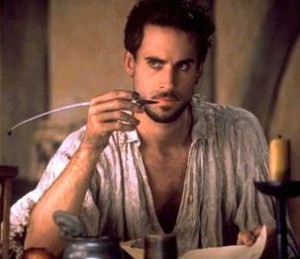 Joseph Fiennes in Shakespeare in Love
Joseph Fiennes in Shakespeare in Love
Verse is somewhat easier to memorize but not enough to justify the substantial effort it takes for the playwright to create it. Besides, the convenience of the actors has never been a noticeable consideration in the construction of plays.
Verse does accomplish something theatrically useful, but because we now live in a visual culture, it seems counter-intuitive. Verse is actually easier to hear and understand. In addition to content clues, we also get clues about what is being said from rhythm and (when it occurs) rhyme. In an oral/aural culture, greater communicative power is an advantage worth the trouble that versification requires.
Joss Whedon’s new film version of Much Ado About Nothing, which I reviewed at greater length in a previous post, got me thinking about this again. The performances in it are stripped of all conventions regarding “beautiful” Shakespeare, but there is a ferocious intensity around conveying the narrative. See it, or should I say listen to it, if you want to hear what verse is for.
